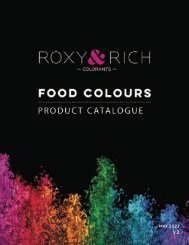Keylink-Brochure-2023
You also want an ePaper? Increase the reach of your titles
YUMPU automatically turns print PDFs into web optimized ePapers that Google loves.
What is meant by shelf life?<br />
The term shelf life refers to the time in which a product is<br />
safe to consume and keeps its original form and texture.<br />
If not prepared and stored correctly, food can become<br />
susceptible to microbial growth (the growth of dangerous<br />
bacteria), making it harmful for human consumption and<br />
creating potential ‘off’ flavours.<br />
Every product is susceptible to some form of microbial<br />
change and the below are often the main culprits:<br />
Contamination and poor hygiene practices<br />
Your chocolate can easily spoil if contaminated with water<br />
or unclean tools and surfaces.<br />
Fresh ingredients<br />
While fresh ingredients such as cream have their obvious<br />
benefits, their higher water content inevitably equals a<br />
shorter shelf life.<br />
Air pockets and cavities in chocolate shells<br />
Any gaps in a filled chocolate can create a breeding ground<br />
for bacteria, as well as drying out your filling and changing<br />
the texture.<br />
Ingredients storage<br />
Ingredient contents should be stored in airtight containers<br />
prior to use and once opened, stored in cool conditions<br />
away from areas with high moisture levels. Chocolate in<br />
particular can also absorb flavours from its surrounding<br />
environment.<br />
Storage conditions of finished chocolates<br />
Storing finished chocolates away from moisture and at the<br />
correct temperature is also important to prevent bloom<br />
and spoilage.<br />
How can I extend my shelf life?<br />
Convenience and long life products<br />
These are ready-to-use products that already have<br />
a more stable structure, so offer a longer shelf life.<br />
These usually cover products such as Cremas,<br />
UHT cream and pre-made ganache.<br />
Freezing chocolates as a storage option for finished<br />
chocolates<br />
Finished chocolates can actually be frozen! Provided<br />
they are in an airtight container, this is an ideal option for<br />
keeping your chocolates ready for when you need them.<br />
They should be defrosted over several days.<br />
Culinary alcohols and alternative sugars<br />
Using culinary alcohols (60% proof or higher) acts as<br />
a preservative. The alcohol sterilises the environment<br />
within your chocolates and helps to prevent microbial<br />
growth. When it comes to using alternative sugars<br />
for shelf life extension, sorbitol (a sugar alcohol)<br />
prevents bacterial growth, and invert sugar is hygroscopic,<br />
absorbing moisture.<br />
General shelf life calculation<br />
Working out the exact timings of shelf life often requires<br />
extreme precision on exactly when a product may<br />
‘turn’. However, the below options can help in<br />
ascertaining shelf life:<br />
Weekly batch testing of your product. Cutting open one<br />
chocolate 1-2 times a week will soon tell you if there are<br />
signs of spoilage or a change in flavour.<br />
Calculating any water activity using an AW meter (water<br />
attracts bacterial growth).<br />
The keys are to use as little water as you can, and give<br />
bacteria as few chances to grow as possible!<br />
Following all the advice outlined above will help you<br />
navigate your shelf life challenges. If you would like<br />
to learn more about shelf life, you can watch our live<br />
stream with the UK Chocolate Academy! You can also<br />
download a handy guide, containing recipes, via the link<br />
in the shared video.<br />
View a recording of our<br />
shelf-life livestream -<br />
scan the QR code.<br />
) 0114 245 5400 X www.keylink.org Live Chat 31

















